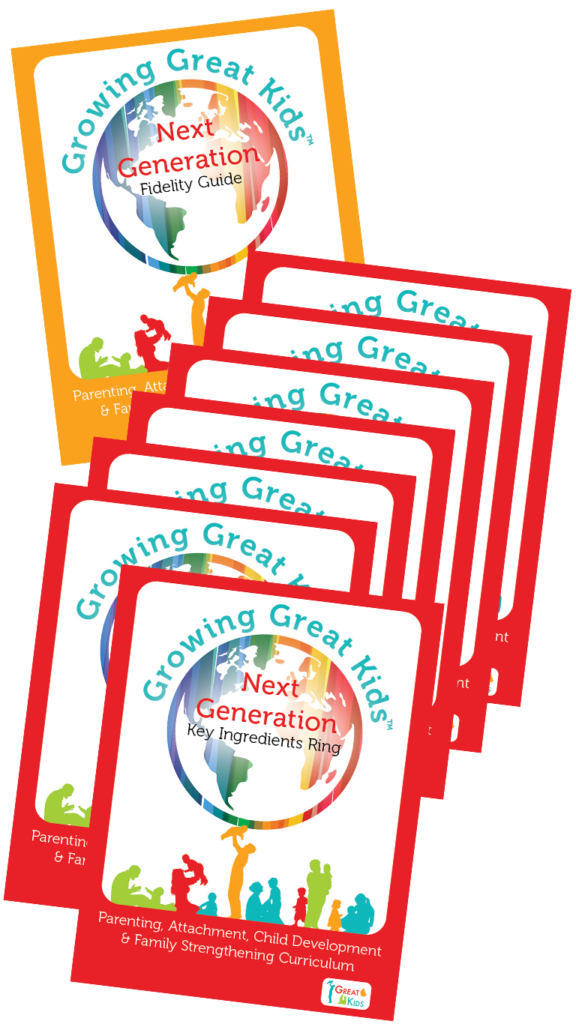Breastfeeding is a very broad topic that has been rigorously researched in the United States as well as throughout the world. In today’s post we will anchor our discussion around the current US statistical information and the benefits of breastfeeding for the baby, mom, and the family as a whole. Given that breastfeeding is a personal and family choice, this topic tends to create a level of uncertainty regarding when and how to start these conversations with program families. For this reason, we will also explore the ways that the GGK curriculum supports your approach to breastfeeding-related topics during home visits.
Let’s start by reviewing the recommendations provided by the American Academy of Pediatrics (AAP). Their most recent breastfeeding policy statement, published in 2012, reaffirmed the recommendation of exclusive breastfeeding for about 6 months, followed by continued breastfeeding as complementary foods are introduced, with continuation of breastfeeding for 1 year or longer as mutually desired by mother and infant (American Academy of Pediatrics, 2012).
The Centers for Disease Control and Prevention (CDC) statistics indicate that while breastfeeding rates in the United States have gone up to 77%, they are still below the desired targets of 81.9% established by the Healthy People 2020 guidelines. The CDC states that there has been progress nationwide in keeping mother and baby together right after birth to support immediate and continued contact between them, which helps the mother establish breastfeeding practices early and learn infant feeding cues. (Centers for Disease Control and Prevention, 2013).
Now let’s talk more specifically about why breastfeeding is a good choice. According to the AAP policy statement (2012), breastfeeding results in improved infant and maternal health outcomes:
Benefits for the Infant:
- Reduced rates of Otitis Media,
- Reduced rates of Gastrointestinal Tract Infections,
- Reduced rates of Sudden Infant Death Syndrome and Infant Mortality,
- Reduced rates of Allergic Disease,
- Reduced rates of Celiac Disease,
- Reduced rates of Inflammatory Bowel Disease,
- Reduced rates of Obesity,
- Reduced rates of Diabetes,
- Reduced rates of Childhood Leukemia and Lymphoma,
- Higher intelligence scores.
Families may wonder about why this variety of health outcomes is so closely linked to breastfeeding. The latest research indicates that there may be many mechanisms that come into play, but most of the findings come back to the idea of the human microbiome. Let’s take a few minutes to explore this topic a bit further.
The microbes that live in the human gastro-intestinal system are critical for our well-being. “Imbalances in the normal gut microbiota have been shown to correlate with a range of diseases.” (Pop, 2012) The first few years of life critically shape the composition of bacteria that will inhabit that individual’s body for years to come and much of that composition is based on diet. “Breast milk has high nutritional content and is important in passing immunological factors from mother to child, as well as nutrients that are essential for gut colonization by bacteria.” (The American Microbiome Institute, Inc., 2015)
This demonstrates yet another way that those early parenting choices are critical, in so many ways, for optimizing the child’s development. There are also great benefits to be gained from breastfeeding in regard to the mother’s health.
Benefits for the Mother:
- Decrease in Post-Partum Blood loss,
- More Rapid Involution of the Uterus,
- Decrease in rates of Post-Partum Depression,
- Decrease in rates of Diabetes Type 2,
- Decrease in rates of Hypertension,
- Decrease in rates of Cardiovascular Disease,
- Decrease in rates of Breast Cancer,
- Decrease in rates of and Ovarian Cancer.
When and how do you approach these conversations with program families? As you know, the Growing Great Kids curriculum provides a variety of breastfeeding conversation guides to share with families at different intervals starting during the prenatal phase. GGK is intentionally designed first to explore what the family knows about the topic, what their views, values, and practices are around that area, and then moves into sharing research information, and finally exploring their thoughts about what they would like to consider and/or put into practice. Here are a few places you’ll find these modules:
- GGK Prenatal: Breastfeeding…A Lifetime of Benefits
- GGK: 0-3 Months: Breastfeeding Families
- GGK: 4-6 Months: Feeding Your Growing Baby
- GGK 7-9 Months: Feeding and Nutrition 7-12 Months
- GGK 10-12 Months: Weaning and Self-Feeding Skills
While the topic of breastfeeding might seem challenging for some Home Visitors, it is important always to keep in mind that our role, as home visitors, is to support families by exploring information that will inform their decisions. Following the sequencing of the curriculum is a great starting point!
In addition, prenatal clinics and birthing hospitals can provide contact information on local lactation programs, and there are also many reliable lactation information Internet sources including:
American Academy of Pediatrics www.aap.org
Centers for Disease Control and Prevention www.cdc.gov
Kelly Mom Parenting Breastfeeding www.kellymom.com
La Leche League www.lalecheleague.org
Be sure to also discuss the many social-emotional BENEFITS FOR THE FAMILY that breastfeeding provides. For example, the many opportunities for mom and baby to connect, skin-to-skin and face-to-face, creates feelings of mutual contentment and contributes to the formation of secure attachment relationships – this benefits the whole family!
Works Cited:
Pop, M. (2012). We are what we eat: How the diet of infants effects their gut microbiome. Genome Biology, 152.
The American Academy of Pediatrics (2011). Policy Statement: Breastfeeding and the Use of Human Milk. Pediatrics Volume 129, Number 3, March 2012. Retrieved from http://pediatrics.aappublications.org/content/pediatrics/129/3/e827.full.pdf
The American Microbiome Institute, Inc. (2015, February 12). Breastfeeding plays an important role in microbiome development. Retrieved from microbiomeinstitute.org: http://www.microbiomeinstitute.org/blog/2015/2/12/breastfeeding-plays-an-important-role-in-microbiome-development
The Centers for Disease Control (2013). Breastfeeding Report Card United States 2013. Division of Nutrition, Physical Activity, and Obesity. Retrieved from http://www.cdc.gov/breastfeeding/pdf/2013breastfeedingreportcard.pdf

